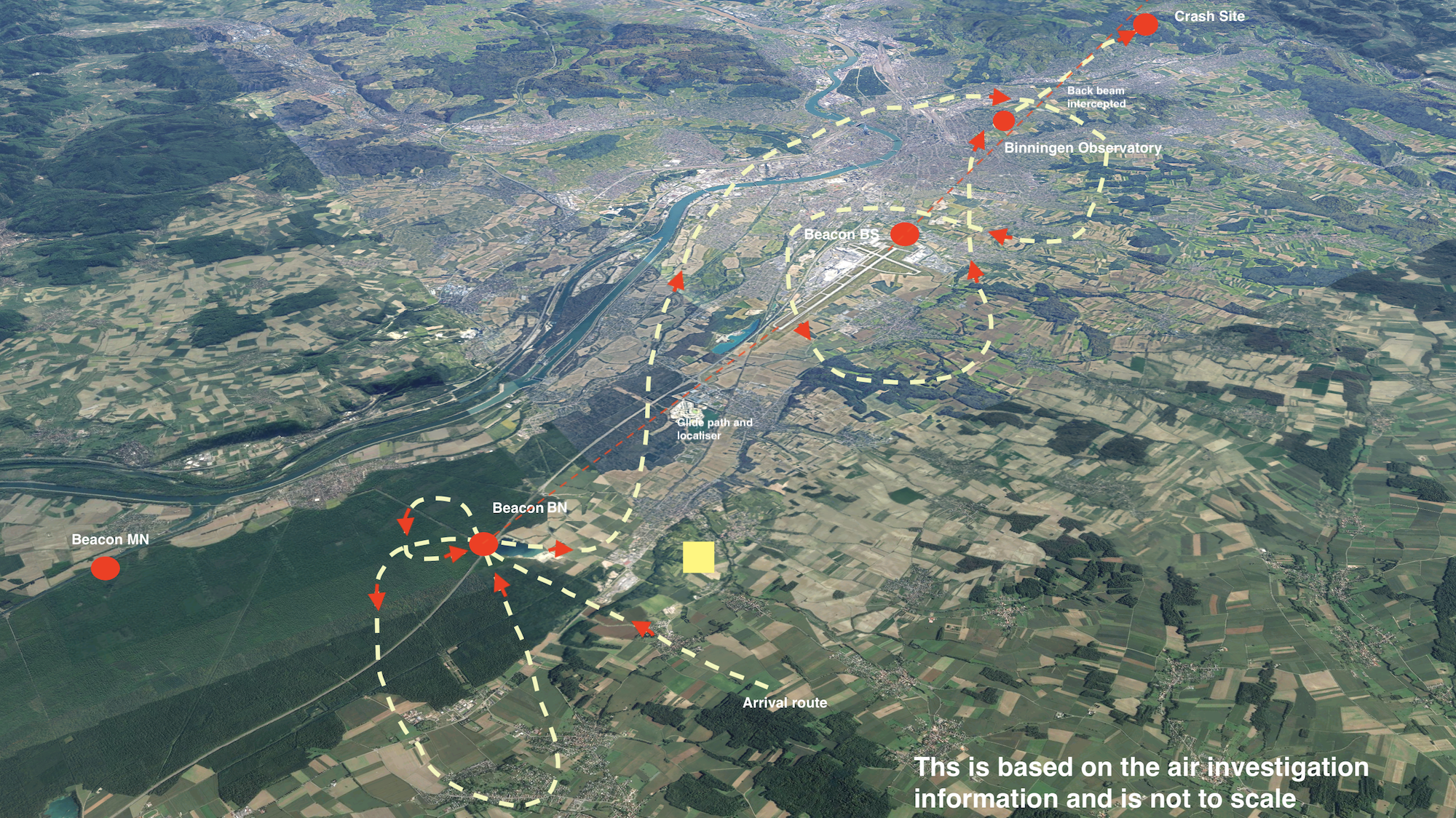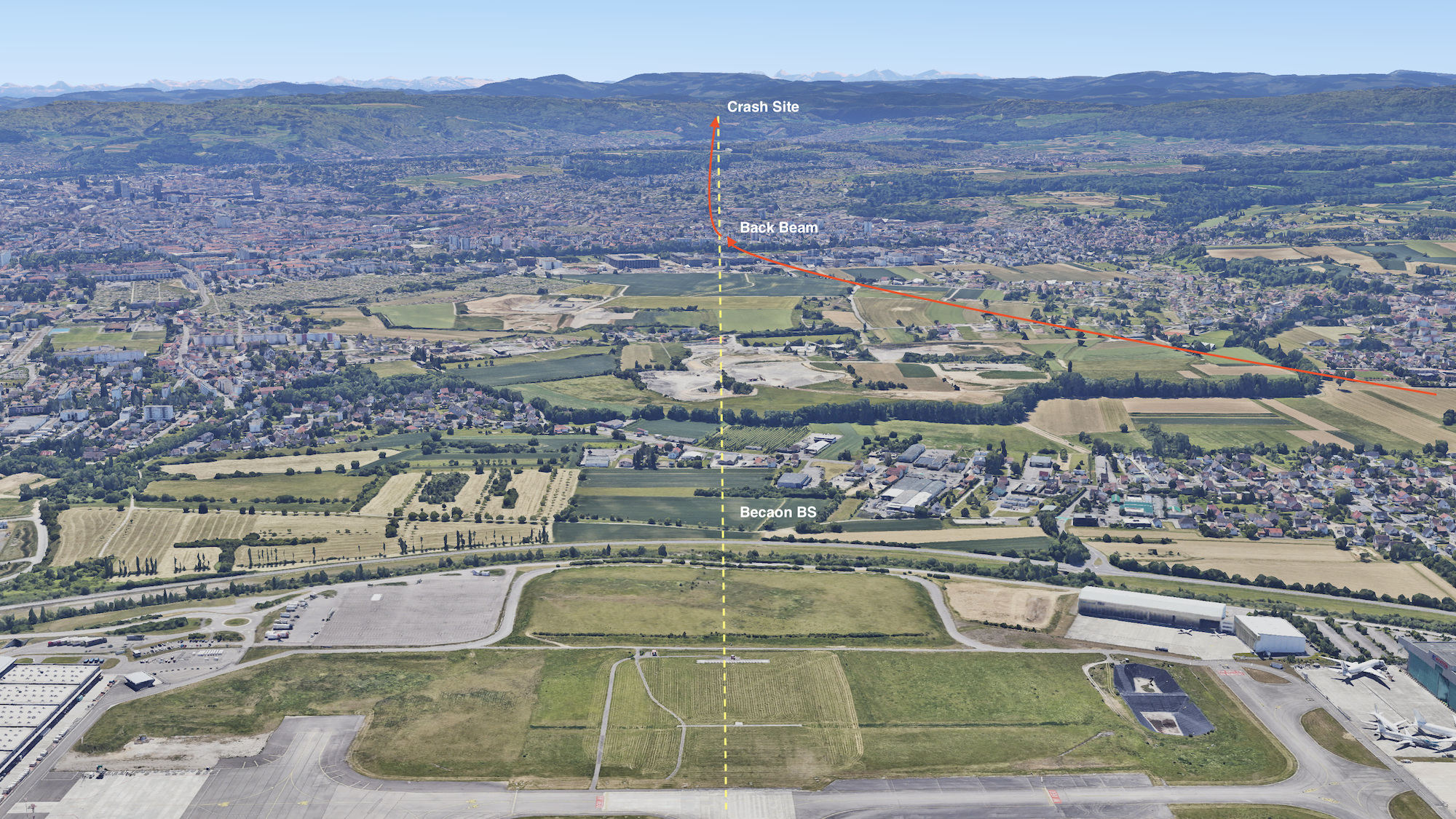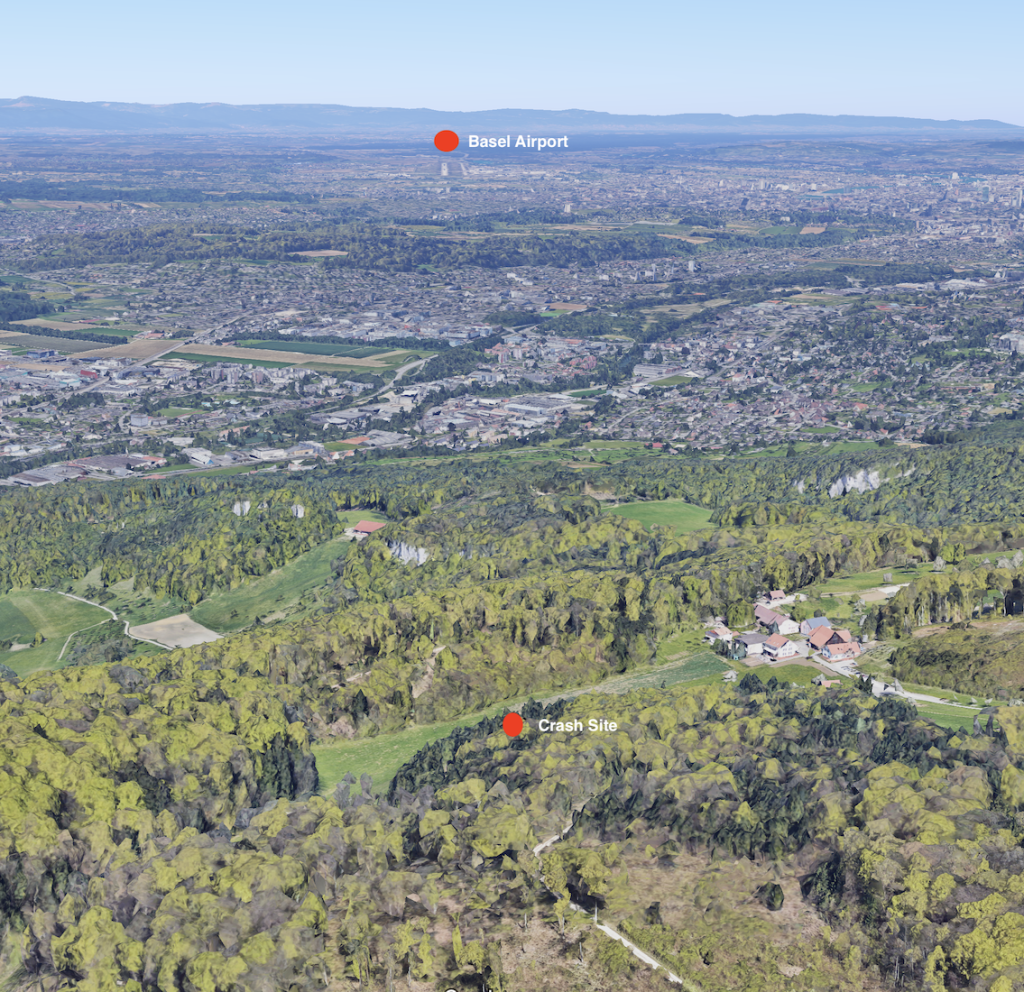The Swiss Air Disaster, April 10th 1973

The aircraft registered as G-AXOP, and was chartered by a tour company based in Britain. Flight 435 took off from Bristol Lulsgate Airport for EuroAirport Basel Mulhouse Freiburg International Airport in Basel, Saint-Louis, France. The airport was located just miles from the border of Switzerland and Germany. Early on the day of the crash, the aircraft departed from London‘s Luton International Airport and made a short positioning flight to Bristol where 139 passengers boarded.
At 07:19 UTC, Flight 435 took off from Bristol. Captain Anthony Dorman flew the plane, while his co-pilot Captain Ivor Terry was handling communication. The flight was uneventful until its first approach. It was daylight at the time, so visual references could be easily obtained by the crew. However, a heavy snowstorm was reported in Basel, thus reducing the visibility there.
Arrival at Basel Airport
At 08:49 UTC, While approaching Basel, the weather was passed to the crew from Air Traffic Control: Wind 360 ° /9kts, visibility (based on runway visual range equipment (RVR) A&B) A=700m, B=1300m, snow, 8/8 cloud at 120m (8/8-full cloud cover), temperature and dew point 0 ° C. The wind was northerly but light, and Flight 435 was going land on runway 16, for an instrument landing.
At 08:55 UTC, Flight 435 was cleared down to, 2500 feet, Flight 435 was due to pass two approach beacons, named Beacon MN and BN, the latter of which was the outer marker of the Instrument Landing System at the airport. At this point, the pilot would pick up the Glide Path localiser into the runway. However, as can be seen in the graphic below the aircraft didn’t turn on Beacon MN but rather turned over Beacon BN twice, then overshot the runway to the left.
At 08:56.58 UTC. The crew radioed that they were approaching 2500 feet. Air Traffic Control reminded the crew to “check MN” as they had not yet done so.
At 08:57.42 UTC Flight 435 passed the runway center line and reported “435 MN” The flight was over 3 nautical miles away from the Beacon MN, but they still reported MN and were given permission to land by Air Traffic Control, “Cleared for approach, check BN on final.“
At 09:00:13 UTC, Captain Dorman then initiated a go-around flying south of the airfield and turning back above Binningen Observatory to make a second approach as was the standard procedure and nothing seemed amiss to the crew or passengers.
At 09:03:38 UTC, The crew reported BN inbound and Air Traffic Control gave permission to land, “435, you are cleared to land on runway 16, wind 230 degrees, 8 knots.”
At 09:05:12 UTC, The crew reported they had overshot the runway and they would go around. Air Traffic Control asked, “OK, what do you intend to do?” Captain Dorman confirmed they would try again, “we’ll try another approach”. At this point, they crossed the runway from the left.

At 09:08 UTC, while Flight 435 was manoeuvring for its second approach, Basel Control Tower received a telephone call from a meteorologist and a former aircraft commander Mr R Beck, reporting that barely two minutes previously, Flight 435 had flown above the Binningen Observatory (approximately eight kilometers southeast of the airport) at a height of around fifty meters while heading south; he urged the crews of Flight 435 to climb immediately. During the approach, several passengers briefly saw several houses on the ground.
While Mr Beck was still on the phone, the crew reported that they had passed the first beacon, named MN. They were instructed to pass the second beacon, BN. In reality, when the crew reported over MN, they were actually in the vicinity of a third beacon, BS, and had already overflown the airport, heading south. This is the transcript of that call:
TWR – Basle ATC tower, BECK – R Beck (at Binningen)
TWR – hello
BECK – hello the tower
TWR – yes good morning
BECK – yes good morning monsieur, this is Beck at the Basle – Binningen observatory
TWR -yes
BECK – there is an aircraft which has just passed two minutes ago heading south
TWR – yes
BECK – ah, probably aha four-engined turbo-prop
TWR – yes
BECK – probably, and it is flying at barely 50 metres and then it is snowing very heavily and I have the impression if it remains like this it will crash in the mountains
TWR – ah hold on you are really sure that is flying at 50 metres?
BECK – yes certainly listen, I was a pilot with Swissair I have just now retired ba
TWR – ah, agreed (two conversations simultaneously)
BECK – I work here (two conversations simultaneously) …I am telephoning you it was here at a maximum of 50 metres south of the observatory here
Mr Mao can be heard saying ‘an aircraft which was flying at 50 metres above the observatory, everything was blotted out, it is a former Swissair pilot who is on the telephone.’
TWR – right, thank you
BECK – it had a red tail unit, I could not I did not have time to see the markings
TWR – yes but because you are being… (pause)… there is an aircraft which has just overshot there which is going to return over…… (two conversations simultaneously)
BECK – it must be made to climb
TWR – yes agreed thank you
At 09:11 UTC, Zurich Area Control Centre asked Basel Control whether they had an aircraft which was flying outbound from the airport towards Hochwald, as they had observed an unidentified echo on their radar screen, a few miles south of Basel. Basel Control Tower said they didn’t, but when the controller checked his radar screen he saw an unidentified echo moving to the south, a few miles from the airport. However, although there must have been a question about this, Flight 435, having reported that it had passed beacon BN, was given a landing clearance.
This the transcript from the Basel Tower and Zurich Air Control Centre. – B/M – Basle aerodrome controller, ZH -Zurich Area Control Centre

B/M – yes hello
Z/H – tell me, you have someone who has taken off who is now crawling towards Hochwald?
B/M – ah! Who is on the Hochwald side? We have an aircraft which has overshot, yes, but it is going to return to BN.
Z/H- ah! It is…
B/M – hold on hold on
Z/H-it has a heading for Hochwald
B/M – what?
The Basle controller radios to Flight 435, who has just called BN. ‘435 you are cleared to land you report light in sight the wind now 320/8kts’ The Vanguard replied simply ‘thank you.’
Z/H- it has a heading for Hochwald
B/M – towards Hochwald, hold on
Z/H – what is its flight level?
B/M – ah! Yes, I see one in that direction which is heading for Hochwald now you will be told that at once…
Basle aerodrome controller observes an unidentified radar echo 6 Ns south of the aerodrome along the runway centreline.
B/M – yes hello, you must check with Paris because the aircraft has supposedly passed BN it has just contacted us, ours has passed BN
Z/H – it is probably a VFR but that’s not on now
B/M – eh
Z/H – we cannot see it any more now, eh right agreed many
B/M – yes right
Z/H – thank you
B/M – cheers
Call ends 09:12.10
After finishing his telephone call with Zurich, the Basel controller asked if Flight 435 was sure that they had passed beacon BN. Flight 435 replied that they had a “spurious indication” and that they were joining the localiser, an electronic signal marking the extended center-line of the runway. The crew then confirmed that they were established on the glide path and localiser, while the controller stated that he could not see them on his radar screen. The controller then informed the crew: “I think you are not on the…you are on the south of the airfield.” Flight 435 didn’t respond. After this message, all calls to Flight 435 went unanswered.t.

At 09:13 UTC, the aircraft brushed the wooded area of a range of hills in Jura and crashed in the hamlet of Herrenmatt, in the parish of Hochwald, some ten miles (16 km) south of the airport and while flying away from it. The aircraft somersaulted and exploded, several parts of it catching fire. 108 passengers and crew were killed, while 37 others survived the crash; 36 of these were injured, and one aircrew was unhurt
On hitting the ground, the aircraft snapped into several sections. While the front parts were “destroyed into bits”, a section of the tail was left substantially intact. This was the area where most survivors were found. Everyone seated in the front part of the aircraft had been killed.
In the aftermath of the crash, survivors began helping each other. It was snowing at the time, and hypothermia could easily occur. While pulling bodies from the wreckage, they began chanting hymns to keep their spirits high. Shortly afterward, a boy from a nearby farm found the survivors and led them to his house, where his family sheltered and took care of them while waiting for rescue services to arrive.
This video shows the scene of the crash site, you may not want to watch this.
Malcolm Smith, the Bristol Post reporter who travelled to the site, reported from the village of Herrenmatt, Dornach, near Basle:
A boy of 14 from Somerset stood on the steps of the old school house here this afternoon and wept unashamedly, comforted by a woman officer of the Salvation Army. ‘Inside the building he had just witnessed the most sobering of all moments – seeing laid in rows the dark-stained coffins of the victims of the Vanguard crash.
Malcolm Smith, Bristol Post
It was the moment when my courage failed. I could not ask his name. This was his moment to be alone and the emotion swept through the small gathering of onlookers and the grey uniformed police who cast their gaze away from the pitiful scene. This is the darkest hour for the relatives and friends who faced the awful task of identifying their loved ones. It was harrowing to them all and they faced the challenge nobly.
There was the impassive husband clutching a polythene bag with a coat and a handbag inside. There was the family group distressed but calm in the face of failure to find any clue which pointed to what happened to their daughter, an 18-year-old with a love of flying.
Dornach this afternoon is bathed in sunshine. On the mountainside, still snow – covered a few miles away, lies the wreckage of Oscar Papa.
To date, this is the deadliest aviation accident to occur in Switzerland. Many of the 139 passengers on the charter flight were women from Congresbury, Axbridge, Cheddar, Winscombe, Yatton, Wells, Wrington, Redhill, Claverham, the surrounding villages and across Bristol. The accident left 55 children motherless and became known in the British media as the Swiss Air Disaster.
The investigators of the crash in their final report recommended that Basel Airport provide radar guidance to inbound aircraft; that the radio beacons in the Basel area emit modulated signals as required by ICAO; that unpublished ILS back beams be suppressed; that approach charts contain information to help pilots cross-check their location relative to nearby radio navigational aids; and that all aircraft over a certain size be equipped with a ground proximity warning system.
Today, all of these improvements have been implemented, mostly in response to a series of crashes rather than due to the accident of Oscar Papa. That such an accident could not happen today, provides little comfort to the families of the victims 50 years later, who still grapple with the simultaneous loss of so many members of their families.
The video below shows a compilation of the news coverage from 1973 up to the 40th Anniversary in 1993.
